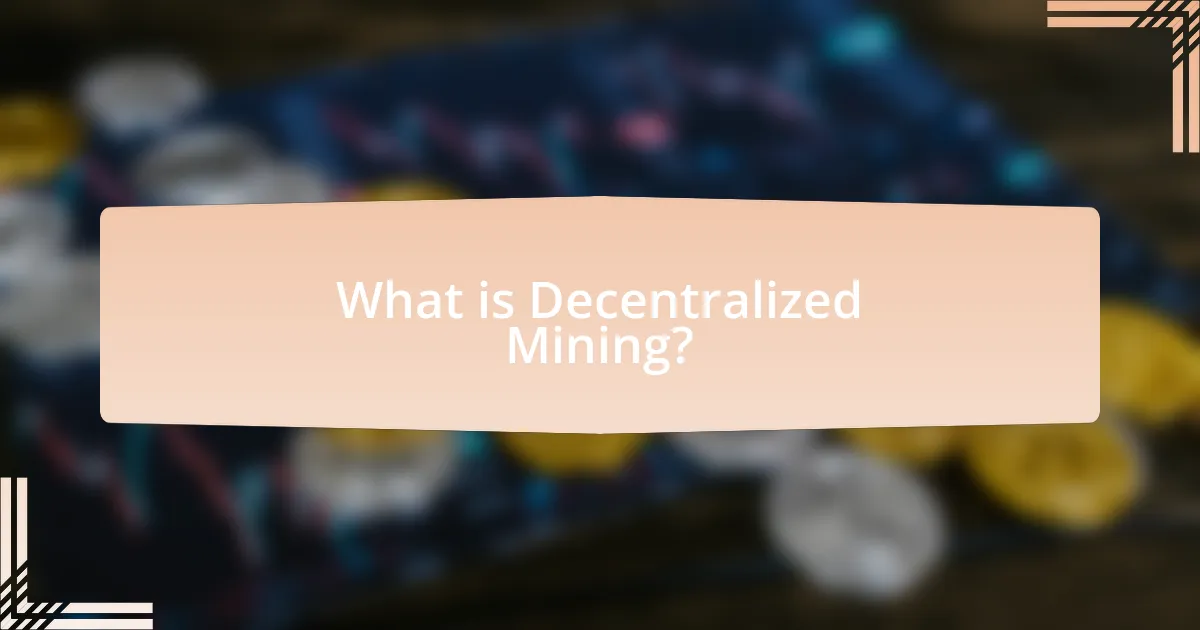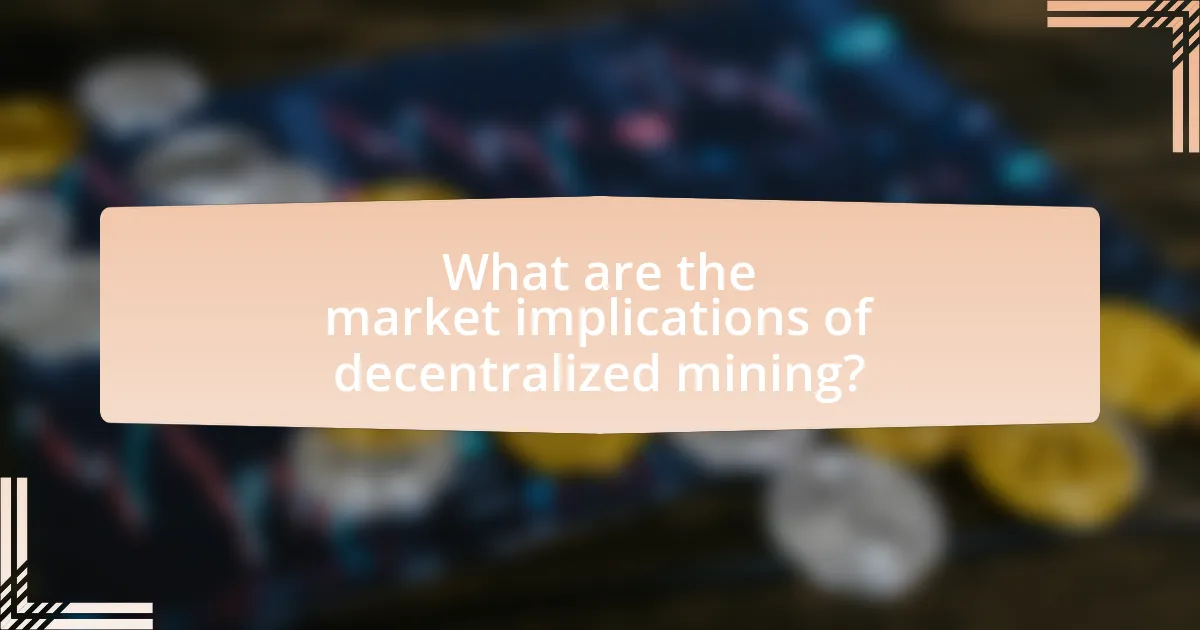Decentralized mining is a distributed approach to cryptocurrency mining that enhances security and reduces centralization risks by allowing multiple participants to contribute computational power. This article explores the differences between decentralized and traditional mining, the technologies that enable decentralized mining, and its growing popularity driven by accessibility and energy efficiency. It also examines the market implications of decentralized mining, including its impact on cryptocurrency markets, profitability, and the challenges it faces, such as regulatory uncertainty and scalability issues. Additionally, the article discusses future prospects, innovations, and best practices for miners operating in decentralized environments.

What is Decentralized Mining?
Decentralized mining refers to the process of cryptocurrency mining that is distributed across a network of participants rather than being controlled by a single entity or organization. This approach enhances security and reduces the risk of centralization, which can lead to manipulation or control over the mining process. In decentralized mining, individuals or groups contribute their computational power to validate transactions and secure the blockchain, often through a consensus mechanism like proof of work or proof of stake. The effectiveness of decentralized mining is supported by the fact that it promotes a more resilient and democratic network, as evidenced by the growth of decentralized networks like Bitcoin and Ethereum, which rely on a vast number of independent miners to maintain their integrity and functionality.
How does decentralized mining differ from traditional mining?
Decentralized mining differs from traditional mining primarily in its structure and control. In decentralized mining, the process is distributed across a network of participants, allowing individuals to contribute computing power without relying on a central authority. This contrasts with traditional mining, where a few large entities often dominate the process, controlling significant resources and infrastructure.
Decentralized mining enhances security and reduces the risk of central points of failure, as evidenced by the Bitcoin network, which operates on a decentralized model where thousands of miners validate transactions. In contrast, traditional mining can lead to centralization, as seen in mining pools that consolidate power among a limited number of participants. This fundamental difference in control and structure impacts the overall resilience and accessibility of the mining process.
What technologies enable decentralized mining?
Decentralized mining is enabled by technologies such as blockchain, peer-to-peer networks, and distributed ledger technology. Blockchain technology allows for the secure and transparent recording of transactions, which is essential for validating mining activities without a central authority. Peer-to-peer networks facilitate direct communication and resource sharing among miners, enhancing collaboration and efficiency. Distributed ledger technology ensures that all participants have access to the same data, promoting trust and reducing the risk of fraud. These technologies collectively support a decentralized approach to mining, allowing for greater participation and resilience in the mining ecosystem.
How does the decentralization process impact mining efficiency?
Decentralization enhances mining efficiency by distributing computational power across a broader network, reducing the risk of central points of failure. This distribution allows for increased participation from various miners, which can lead to more consistent block validation times and improved network security. For instance, a study by the Cambridge Centre for Alternative Finance indicates that decentralized mining operations can lead to a more resilient network, as they mitigate the risks associated with mining pools that dominate the market. Additionally, decentralized mining can lower operational costs by enabling miners to select optimal locations based on energy prices, thus improving overall profitability and efficiency.
Why is decentralized mining gaining popularity?
Decentralized mining is gaining popularity due to its ability to enhance security, reduce centralization risks, and empower individual miners. This shift allows participants to contribute to the network without relying on large mining pools or centralized entities, which can manipulate the market. According to a report by the Cambridge Centre for Alternative Finance, the share of decentralized mining has increased significantly, reflecting a growing preference for more equitable participation in blockchain networks. Additionally, advancements in technology, such as more efficient mining hardware and improved software, have made it easier for individuals to engage in decentralized mining, further driving its adoption.
What are the key trends driving the rise of decentralized mining?
The key trends driving the rise of decentralized mining include increased accessibility, enhanced security, and the growing demand for energy-efficient solutions. Increased accessibility is facilitated by advancements in technology that allow individuals to participate in mining without the need for expensive hardware, as seen with cloud mining services. Enhanced security is achieved through decentralized networks that reduce the risk of single points of failure, making the mining process more resilient against attacks. Additionally, the demand for energy-efficient solutions is rising due to environmental concerns, prompting miners to adopt renewable energy sources and innovative technologies that minimize energy consumption. These trends collectively contribute to the growing popularity and viability of decentralized mining in the cryptocurrency ecosystem.
How do regulatory changes influence decentralized mining adoption?
Regulatory changes significantly influence decentralized mining adoption by either facilitating or hindering its growth. For instance, favorable regulations, such as those that provide clear legal frameworks for cryptocurrency operations, can encourage more individuals and businesses to engage in decentralized mining. Conversely, stringent regulations, such as bans on cryptocurrency mining or high taxation, can deter participation and limit the expansion of decentralized mining networks. A notable example is China’s crackdown on cryptocurrency mining in 2021, which led to a substantial decline in mining activity within the country, pushing miners to relocate to more favorable jurisdictions. This shift illustrates how regulatory environments directly impact the viability and attractiveness of decentralized mining.

What are the market implications of decentralized mining?
Decentralized mining significantly alters market dynamics by reducing the concentration of power among a few large mining entities, thereby promoting competition and potentially lowering transaction fees. This shift encourages more participants to engage in mining, which can lead to increased network security and resilience. For instance, as of 2023, Bitcoin’s mining landscape has seen a rise in small-scale miners, contributing to a more distributed hash rate, which enhances the overall stability of the network. Additionally, decentralized mining can lead to price volatility as increased participation may influence supply and demand dynamics in cryptocurrency markets.
How does decentralized mining affect cryptocurrency markets?
Decentralized mining positively impacts cryptocurrency markets by enhancing security and reducing centralization risks. This mining approach distributes the power to validate transactions across a wider network of participants, which mitigates the risk of a single point of failure or manipulation. For instance, Bitcoin’s decentralized mining structure has contributed to its resilience against attacks, as evidenced by its sustained market presence despite numerous challenges since its inception in 2009. Furthermore, decentralized mining fosters greater participation, leading to increased network activity and liquidity, which can drive up market prices. The rise of mining pools and accessible mining hardware has democratized participation, allowing more individuals to contribute to the network, thereby strengthening the overall ecosystem.
What role does decentralized mining play in market volatility?
Decentralized mining significantly influences market volatility by distributing mining power across a broader network, which reduces the risk of centralization and manipulation. This distribution leads to a more stable and resilient network, as no single entity can exert excessive control over the mining process or the associated cryptocurrency supply. For instance, Bitcoin’s decentralized mining structure has historically contributed to its price fluctuations, as changes in mining difficulty and hash rate can impact the rate at which new coins are generated, thereby affecting supply dynamics. Additionally, decentralized mining can lead to increased participation from smaller miners, which can enhance market liquidity and reduce the impact of large sell-offs by major players. This dynamic was evident during the 2020 Bitcoin halving event, where decentralized mining helped mitigate extreme price volatility by ensuring a steady supply of new coins despite reduced block rewards.
How can decentralized mining influence mining profitability?
Decentralized mining can significantly influence mining profitability by reducing operational costs and increasing competition among miners. By distributing mining power across a network, decentralized mining eliminates the need for large, centralized mining farms, which often incur high electricity and maintenance expenses. This shift allows smaller miners to participate in the network, fostering a competitive environment that can lead to lower transaction fees and higher rewards for miners. Additionally, decentralized mining enhances network security and resilience, which can stabilize profitability over time. For instance, studies have shown that decentralized networks can maintain consistent block rewards, even as difficulty levels fluctuate, thereby providing a more predictable income stream for miners.
What challenges does decentralized mining face in the market?
Decentralized mining faces significant challenges in the market, primarily including regulatory uncertainty, scalability issues, and competition from centralized mining operations. Regulatory uncertainty arises as governments worldwide grapple with how to classify and regulate cryptocurrencies, which can impact the legality and viability of decentralized mining initiatives. Scalability issues are evident as decentralized networks often struggle to process transactions quickly and efficiently, leading to delays and increased costs. Additionally, competition from centralized mining operations, which benefit from economies of scale and lower operational costs, poses a threat to the profitability and sustainability of decentralized mining efforts. These challenges hinder the growth and adoption of decentralized mining in the broader cryptocurrency ecosystem.
What are the security risks associated with decentralized mining?
Decentralized mining presents several security risks, including the potential for 51% attacks, where a single entity gains control over the majority of the network’s mining power, allowing them to manipulate transactions. Additionally, the lack of centralized oversight can lead to vulnerabilities in the network’s consensus mechanism, making it susceptible to double-spending attacks. Furthermore, decentralized mining operations often rely on a diverse range of hardware and software, which can introduce inconsistencies and security flaws, increasing the risk of exploitation by malicious actors. According to a study by the University of Cambridge, the decentralized nature of mining can also complicate the enforcement of security protocols, leading to a higher likelihood of breaches.
How do scalability issues impact decentralized mining operations?
Scalability issues significantly hinder decentralized mining operations by limiting the number of transactions that can be processed simultaneously. When a blockchain network experiences high demand, the inability to scale can lead to increased transaction times and higher fees, discouraging miners from participating. For instance, Bitcoin’s network has faced congestion during peak periods, resulting in transaction delays and costs that can exceed $50 per transaction. This inefficiency can deter new miners and reduce overall network security, as fewer participants may lead to centralization risks. Thus, scalability challenges directly affect the operational viability and attractiveness of decentralized mining.

What are the future prospects for decentralized mining?
The future prospects for decentralized mining are promising, driven by advancements in blockchain technology and increasing demand for energy-efficient solutions. As more individuals and small entities participate in mining, the network becomes more resilient and less susceptible to centralization risks. The rise of renewable energy sources, such as solar and wind, further enhances the viability of decentralized mining by reducing operational costs and environmental impact. Additionally, innovations in mining hardware and software are expected to improve efficiency and accessibility, making decentralized mining more attractive. According to a report by the Cambridge Centre for Alternative Finance, the share of decentralized mining has been steadily increasing, indicating a shift towards a more distributed mining landscape.
How might technological advancements shape decentralized mining?
Technological advancements will significantly enhance decentralized mining by improving efficiency, reducing costs, and increasing accessibility. Innovations such as more efficient algorithms, advanced hardware like ASIC miners, and the integration of renewable energy sources can lower energy consumption and operational expenses. For instance, the development of energy-efficient mining rigs has been shown to reduce electricity costs by up to 50%, making mining more viable for individuals and small entities. Additionally, advancements in blockchain technology, such as sharding and layer-2 solutions, can facilitate faster transaction processing and lower fees, further encouraging participation in decentralized mining networks. These improvements collectively contribute to a more robust and inclusive mining ecosystem.
What innovations are on the horizon for decentralized mining?
Innovations on the horizon for decentralized mining include advancements in energy-efficient mining hardware, the integration of renewable energy sources, and the development of decentralized autonomous organizations (DAOs) for mining governance. Energy-efficient hardware, such as ASIC miners with improved power consumption rates, can significantly reduce operational costs and environmental impact. The integration of renewable energy sources, like solar and wind, is becoming more prevalent, allowing miners to operate sustainably and reduce reliance on traditional energy grids. Additionally, DAOs are emerging as a way to democratize decision-making in mining operations, enabling participants to vote on key issues and share profits more equitably. These innovations are supported by ongoing research and development in the blockchain and energy sectors, indicating a shift towards more sustainable and community-driven mining practices.
How could changes in user behavior affect the future of decentralized mining?
Changes in user behavior could significantly impact the future of decentralized mining by altering demand for mining resources and influencing network participation. For instance, if users increasingly prioritize energy efficiency and sustainability, decentralized mining operations may need to adopt greener technologies to remain competitive. According to a report by the Cambridge Centre for Alternative Finance, the shift towards renewable energy sources in mining has already gained traction, with 39% of Bitcoin mining powered by renewable energy as of 2021. Additionally, if users become more educated about the benefits of decentralized systems, this could lead to increased participation, enhancing network security and stability. Conversely, if users favor centralized solutions for convenience, decentralized mining could face reduced interest, potentially leading to a decline in its growth and innovation.
What best practices should miners follow in a decentralized environment?
Miners in a decentralized environment should prioritize security, transparency, and collaboration. Implementing robust security measures, such as using hardware wallets and multi-signature transactions, protects assets from theft and hacking. Transparency in operations, including clear communication of mining practices and rewards distribution, fosters trust within the community. Additionally, collaboration with other miners through pooling resources can enhance efficiency and profitability, as evidenced by the rise of mining pools that allow smaller miners to compete effectively. These practices are essential for sustaining a healthy decentralized mining ecosystem.
How can miners optimize their operations in decentralized networks?
Miners can optimize their operations in decentralized networks by utilizing advanced algorithms and efficient hardware to enhance processing power and reduce energy consumption. Implementing strategies such as pooled mining allows miners to combine resources, increasing the likelihood of earning rewards while minimizing individual risk. Additionally, miners can leverage geographic diversification to access cheaper electricity and favorable regulatory environments, which can significantly lower operational costs. According to a study by the Cambridge Centre for Alternative Finance, miners who strategically locate their operations in regions with low energy prices can reduce costs by up to 30%.
What strategies can enhance security in decentralized mining?
Implementing multi-signature wallets enhances security in decentralized mining by requiring multiple private keys to authorize transactions. This strategy mitigates the risk of single-point failures and unauthorized access, as it necessitates consensus among several parties before any funds can be moved. Additionally, utilizing secure hardware wallets for key storage further protects against hacking attempts, as these devices are designed to keep private keys offline. According to a report by the Blockchain Security Alliance, multi-signature wallets have reduced theft incidents in cryptocurrency transactions by over 50%, demonstrating their effectiveness in enhancing security.